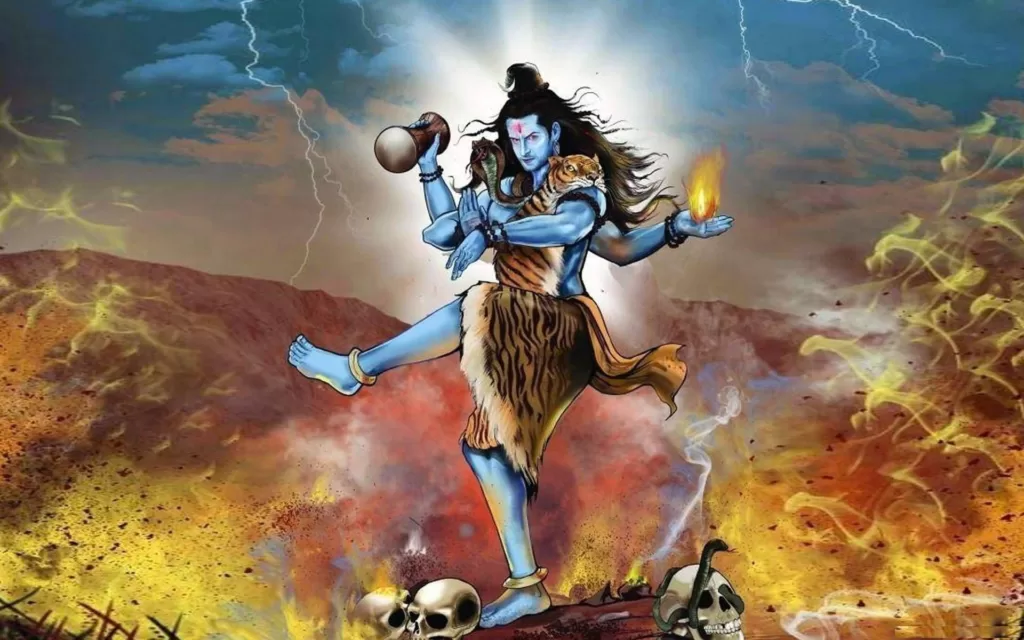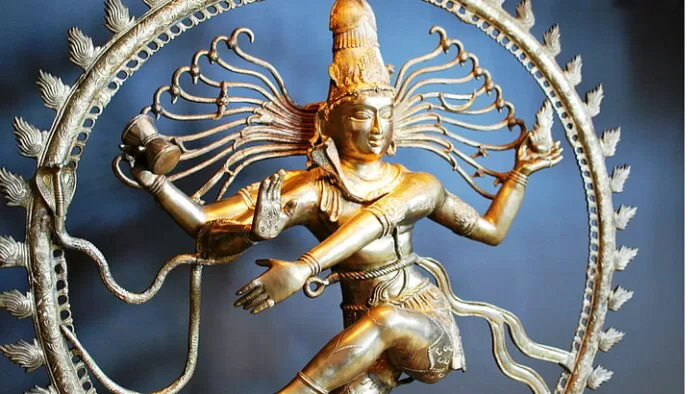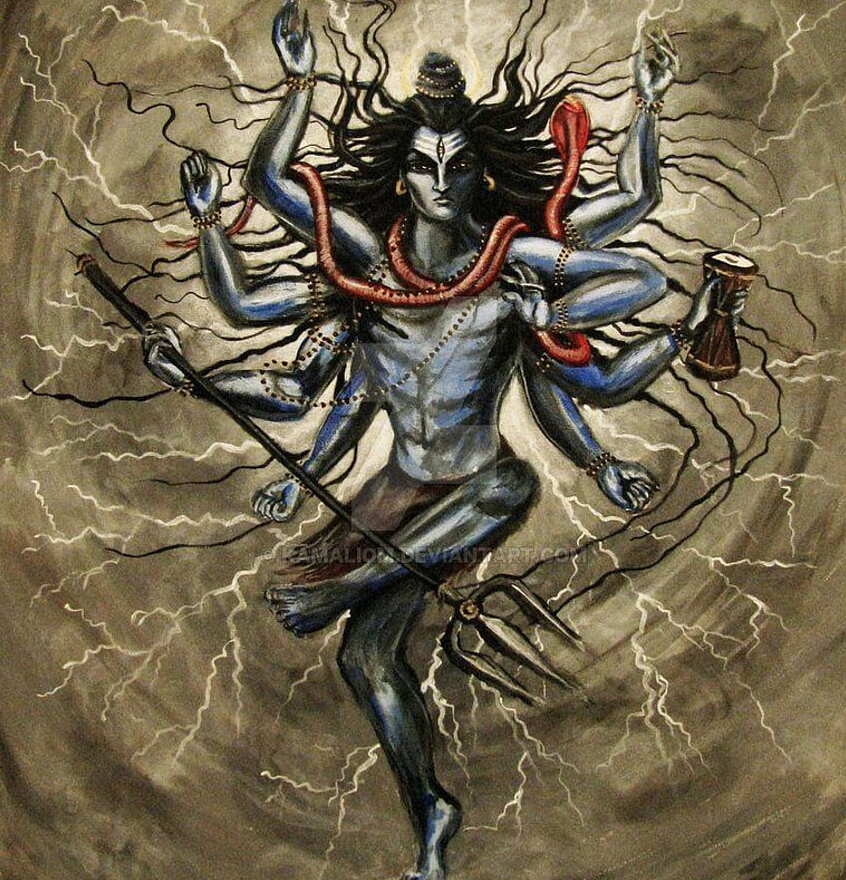Shiva Stotram is a devotional hymn or chant dedicated to Lord Shiva, one of the principal deities in Hinduism. Lord Shiva is often referred to as the “Destroyer” in the Holy Trinity of Hindu gods, alongside Brahma, the “Creator,” and Vishnu, the “Preserver.”
Shiva Stotrams are composed in various forms, such as poems, verses, or songs, and they express profound reverence, praise, and devotion to Lord Shiva. Devotees typically recite or sing these stotrams in order to obtain blessings, protection, and spiritual enlightenment.

Are there many Shiva Stotrams?
There are numerous Shiva Stotrams in Hindu literature, each highlighting different aspects of Lord Shiva’s personality, his attributes, and his role in the cosmos. Some well-known examples of Shiva Stotrams include the “Shiva Tandava Stotram,” which describes Lord Shiva’s cosmic dance; the “Maha Mrityunjaya Mantra,” a powerful mantra for protection and healing; and the “Rudrashtakam,” which extols Lord Shiva’s various qualities.
These stotrams are not only revered for their spiritual significance but are also appreciated for their literary beauty and cultural importance within the Hindu tradition. They are recited during various religious ceremonies, festivals, and personal worship practices by devotees who seek to establish a deeper connection with Lord Shiva.
What is the purpose of daily Shiva stotram recitation?
Reciting Shiva Stotrams daily holds great significance in Hinduism, particularly for devotees of Lord Shiva. Here are some of the reasons why individuals choose to recite Shiva Stotrams on a daily basis:
Devotional Connection:
Regular recitation of Shiva Stotrams helps devotees establish and maintain a deep emotional and spiritual connection with Lord Shiva. It allows them to express their devotion, reverence, and love for the deity.
Spiritual Upliftment:
Shiva stotrams often contain profound philosophical and spiritual teachings. By reciting them daily, individuals engage with these teachings, which can lead to increased self-awareness, spiritual growth, and a sense of inner peace.
Blessings and Protection:
Many Shiva stotrams invoke Lord Shiva’s blessings and protection. Devotees believe that by reciting these hymns, they can seek the deity’s grace, guidance, and blessings in various aspects of life, including health, family, career, and spiritual journey.
Removal of Obstacles:
Lord Shiva is often considered the remover of obstacles and challenges. Reciting Shiva Stotrams daily is believed to help individuals overcome difficulties and hurdles in their lives.
Purification and Cleansing:
The act of reciting sacred chants is believed to have a purifying effect on the mind and soul. It can help individuals cleanse themselves of negative thoughts, emotions, and energies.
Cultural and Religious Tradition:
Many families and individuals follow a tradition of daily worship and recitation of prayers as a way to maintain their cultural and religious heritage. This practice also helps foster a sense of continuity and connection with ancestral traditions.
Fulfillment of Desires:
Some Shiva Stotrams are dedicated to specific desires, such as health, wealth, knowledge, or spiritual awakening. By reciting these stotrams daily, devotees believe they can manifest their desires in alignment with divine will.
Mindfulness and Focus:
Regular recitation of stotrams requires concentration and focus. This practice can lead to increased mindfulness and a sense of being present in the moment, helping individuals detach from the distractions of daily life.
Expression of Gratitude:
Reciting Shiva Stotrams daily is also a way for devotees to express gratitude for the blessings they have received and to acknowledge the presence of a higher power in their lives.
Cultivation of Bhakti (Devotion):
The practice of daily recitation cultivates a sense of bhakti, or devotion, which is an essential aspect of many spiritual paths in Hinduism.
It’s important to note that the significance of daily recitation can vary from person to person. Some individuals may seek personal fulfillment, while others may approach it as a traditional or cultural practice. Ultimately, the practice of reciting Shiva Stotrams daily is a deeply personal and spiritual choice that allows devotees to connect with their faith and their chosen deity, Lord Shiva.

Meaning of Shiva Tandava Stotram
The legendary Hindu sage Ravana wrote a hymn known as the “Shiva Tandava Stotram,” which is highly regarded. This hymn glorifies the cosmic dance of Lord Shiva, known as the Tandava, which symbolizes creation, preservation, and destruction within the universe. The stotram is known for its rhythmic and powerful verses that describe the dynamic and awe-inspiring nature of Lord Shiva’s dance. The stotram is composed of 16 verses, each portraying different facets of Shiva’s divine dance. Here, I’ll provide a detailed interpretation of its verses:
“Jatatavigalajjala pravahapavitasthale
Galeavalambya lambitam bhujangatungamalikam
Damad damad damaddama ninadavadamarvayam
Chakara chandtandavam tanotu nah shivah shivam”
With a garlanded serpent around his neck, the Damaru drum that makes the sound “Damat Damat Damat Damat Damat,” and the flow of water from his hair consecrated his neck, Lord Shiva performed the auspicious Tandava dance. May he bestow prosperity on us all.
“Jata kata hasambhrama bhramanilimpanirjhari
Vilolavichivalarai virajamanamurdhani
Dhagadhagadhagajjva lalalata pattapavake
Kishora chandrashekhare ratih pratikshanam mama”
I possess a profound fascination with the deity Shiva.
His head is exalted by the successive undulations of the ethereal Ganga river, Which agitate within the profound abyss of his hair in intricate tresses.
The individual possessing the radiant flame ablaze upon the frontal region of their cranium, and the one adorned with a lunar crescent as an embellishment upon their head.
“Dharadharendrana ndinivilasabandhubandhura
Sphuradigantasantati pramodamanamanase
Krupakatakshadhorani nirudhadurdharapadi
Kvachidigambare manovinodametuvastuni”
May one’s consciousness strive for contentment in the divine presence of Lord Shiva, the deity in whose consciousness all sentient beings of the illustrious cosmos reside. He is the esteemed consort of Parvati, the daughter of the king of mountains. With his benevolent gaze, he governs immeasurable hardships, displaying his omnipresence. Furthermore, he adorns the celestial realms as his attire.
“Jata bhujan gapingala sphuratphanamaniprabha
Kadambakunkuma dravapralipta digvadhumukhe
Madandha sindhu rasphuratvagutariyamedure
Mano vinodamadbhutam bibhartu bhutabhartari”
May I derive immense gratification from Lord Shiva, who serves as the patron of all existence, With his serpentine companion adorned with a reddish-brown hood and a radiant gem atop it, Bestowing a diverse array of hues upon the resplendent countenances of the celestial Goddesses representing the cardinal directions, Enveloped in a glistening cloak fashioned from the hide of an enormous, intoxicated elephant.
“Sahasra lochana prabhritya sheshalekhashekhara
Prasuna dhulidhorani vidhusaranghripithabhuh
Bhujangaraja malaya nibaddhajatajutaka
Shriyai chiraya jayatam chakora bandhushekharah”
May it be bestowed upon us by Lord Shiva, the deity adorned with the Moon as a regal headpiece, whose locks are entwined by a crimson serpent garland, and whose pedestal is rendered dusky by the accumulation of floral particles dispersed from the crowns of celestial beings such as Indra and Vishnu.
“Lalata chatvarajvaladhanajnjayasphulingabha
nipitapajnchasayakam namannilimpanayakam
Sudha mayukha lekhaya virajamanashekharam
Maha kapali sampade shirojatalamastunah”
Is it possible for us to acquire the supernatural powers known as Siddhis by accessing the intricate strands of hair belonging to Shiva, the deity who consumed the God of Love through the fiery sparks emanating from his forehead? A captivating crescent moon is adorning this forehead, which celestial leaders revere.
“Karala bhala pattikadhagaddhagaddhagajjvala
Ddhanajnjaya hutikruta prachandapajnchasayake
Dharadharendra nandini kuchagrachitrapatraka
Prakalpanaikashilpini trilochane ratirmama”
My attention is drawn to Lord Shiva, who has three eyes and who sacrificed the great God of Love to fire.
With the sound “Dhagad, Dhagad…”, the horrible surface of his forehead burns.
He is the sole artist skilled at tracing decorative lines on the tips of Parvati’s breasts, the mountain king’s daughter.
“Navina megha mandali niruddhadurdharasphurat
Kuhu nishithinitamah prabandhabaddhakandharah
nilimpanirjhari dharastanotu krutti sindhurah
Kalanidhanabandhurah shriyam jagaddhurandharah”
May Lord Shiva, the god who upholds the cosmos and emits an alluring aura with the presence of the moon and the heavenly river Ganga, bestow it upon us.
The person’s neck has a complexion akin to the pitch-blackness of midnight during a new moon phase, with numerous layers of cloud formations surrounding it.
“Praphulla nila pankaja prapajnchakalimchatha
Vdambi kanthakandali raruchi prabaddhakandharam
Smarachchidam purachchhidam bhavachchidam makhachchidam
Gajachchidandhakachidam tamamtakachchidam bhaje”
I pray to Lord Shiva, whose neck is bound with the brilliance of temples hung with the glory of fully blossomed blue lotus flowers, which resemble the darkness of the cosmos.
Who is the slayer of Manmatha, who destroyed Tripura, who destroyed the bonds of worldly existence, who destroyed sacrifice, who slew the demon Andhaka, who is the destroyer of elephants, and who overcame Yama, the god of death?
“Akharvagarvasarvamangala kalakadambamajnjari
Rasapravaha madhuri vijrumbhana madhuvratam
Smarantakam purantakam bhavantakam makhantakam
Gajantakandhakantakam tamantakantakam bhaje”
I pray to Lord Shiva, whose neck is bound with the brilliance of temples hung with the splendor of completely bloomed blue lotus flowers, which resemble the darkness of the universe.
Who is the slayer of Manmatha, who destroyed Tripura, who destroyed the bonds of worldly existence, who destroyed sacrifice, who destroyed the demon Andhaka, who is the destroyer of elephants, and who overpowered Yama, the god of death?
“Jayatvadabhravibhrama bhramadbhujangamasafur
Dhigdhigdhi nirgamatkarala bhaal havyavat
Dhimiddhimiddhimidhva nanmrudangatungamangala
Dhvanikramapravartita prachanda tandavah shivah”
Shiva, whose magnificent forehead is ablaze with a fire that is expanding as a result of a serpent’s breath, moves in whirling motions across the magnificent sky as a series of loud drum beats producing the sound “Dhimid Dhimid” accompany his Tandava dance.
“Drushadvichitratalpayor bhujanga mauktikasrajor
Garishtharatnaloshthayoh suhrudvipakshapakshayoh
Trushnaravindachakshushoh prajamahimahendrayoh
Sama pravartayanmanah kada sadashivam bhaje”
When will I be able to worship Lord Sadashiva, the eternally benevolent deity, with equanimity toward people and emperors?
Towards a blade of grass and a lotus, toward friends and foes, Towards the most precious gem and a clod of soil, Towards a snake or a garland and the various worldly forms?
“Kada nilimpanirjhari nikujnjakotare vasanh
Vimuktadurmatih sada shirah sthamajnjalim vahanh
Vimuktalolalochano lalamabhalalagnakah
Shiveti mantramuchcharan sada sukhi bhavamyaham”
When will I be joyful, living in a cave near the celestial river Ganga, with my hands constantly clasped on my head, my impure thoughts washed away, reciting the Shiva mantra, devoted to God with a glorious forehead and bright eyes?
“Imam hi nityameva muktamuttamottamam stavam
Pathansmaran bruvannaro vishuddhimeti santatam
Hare gurau subhaktimashu yati nanyatha gatim
Vimohanam hi dehinam sushankarasya chintanam”
Whoever reads, memorizes, and recites these stotrams as stated here is purified for eternity and attains devotion to the great Guru Shiva. There is no alternative or refuge for this devotion. The mere notion of Shiva is sufficient to dispel the delusion.

History of the Shiv Tandav Stotram
Ravana was a ferocious follower of Shiva, and there are numerous tales about him. A devotee shouldn’t attain greatness, but he was a devoted individual. He walked the entire distance from the south to Kailash, where he began to proclaim Shiva’s praises. He used percussion to set the rhythm and spontaneously composed 1008 verses, known as the Shiva Tandava Stotram.
Shiva was so delighted and captivated by this melody. Ravana began his ascent of Kailash’s Southern Face while he sang slowly. When Ravana was nearing the summit and Shiva was still enraptured by his music, Parvati observed this individual climbing up.
There is only room for two people on the roof! So Parvati attempted to rouse Shiva from his musical trance. She proclaimed, “This man is coming all the way up!” But Shiva was too immersed in the music and poetry to notice. Then, ultimately, Parvati was able to free him from his trance, and when Ravana reached the summit, Shiva simply pushed him off with his feet. Ravana rolled down the southern face of Mount Kailash. They say that his drum dragged behind him as he slid down the mountain, leaving a furrow the entire way down. If you examine the South Face, you will notice a straight-down wedge-shaped incision in the center.
It is somewhat inappropriate to distinguish or discriminate between the two faces of Kailash, but the South Face is dear to us because Agastya Muni merged with it. It is merely a South Indian bias that we prefer the South visage, which I believe is the most beautiful visage. It is the face with the whitest complexion, as it is extremely snowy there.
The South Face is, in many respects, the most intense face, yet very few people visit it. It is much less accessible and has a more difficult route than the other faces, and only a select few individuals venture there.
Why should both children and adults recite the Shiva Stotram?
Reciting the Shiva Stotram holds profound benefits for individuals of all ages, young and old alike. This devotional practice transcends generational boundaries and offers unique advantages that contribute to mental well-being, fostering a sense of connectedness, peace, and inner strength.
Firstly, the Shiva Stotram serves as a timeless source of spiritual guidance for the young and old. For the younger generation, it offers an opportunity to connect with the rich cultural and spiritual heritage of Hinduism. It provides a way to explore their roots, fostering a sense of identity and belonging. For the older generation, the stotram reaffirms their lifelong devotion to Lord Shiva, offering them solace and continuity in their spiritual journey.
Secondly, reciting the Shiva Stotram can significantly impact mental well-being. For the youth, the stotram’s rhythmic verses and melodic chants can help reduce stress, anxiety, and the pressures of modern life. It acts as a form of meditation, promoting mindfulness and calming the mind. For the elderly, the practice offers a sense of purpose and spiritual engagement, which can alleviate feelings of loneliness and monotony.
Thirdly, the Shiva Stotram addresses the mental well-being of individuals by instilling a sense of hope and positivity. The stotram’s themes of destruction and creation mirror life’s cyclical nature, teaching us that even in difficult times, there’s potential for renewal. This perspective can help both young and old navigate challenges with greater resilience and optimism.
Fourthly, the act of reciting the Shiva Stotram encourages self-reflection and introspection. Young people can benefit from this practice by developing a deeper understanding of their values and beliefs. For the elderly, it can lead to a sense of closure and self-acceptance, promoting mental clarity and emotional well-being.
Lastly, the Shiva Stotram fosters a sense of community across generations. When young and old come together to recite these sacred verses, it creates an environment of mutual respect and learning. The exchange of wisdom and experiences enriches the practice, promoting intergenerational bonding and emotional support.
Conclusion
The Shiva Stotram holds timeless significance for people of all ages. It nurtures mental well-being by offering a spiritual connection, reducing stress, cultivating positivity, promoting introspection, and fostering intergenerational unity. The practice offers a holistic approach to mental health, combining spirituality, tradition, and community for a more balanced and fulfilling life journey.
Disclaimer:
The author’s views are his or her own. The facts and opinions in the article have been taken from various articles and commentaries available in the online media and Eastside Writers does not take any responsibility or obligation for them.
Note: Contact our Writers at www.eastsidewriters.com for writing Blogs/Articles on any niche. We have experts in various domains from Technology to Finance and from Spirituality to Lifestyle and Entertainment.







Thanks for sharing a great article!